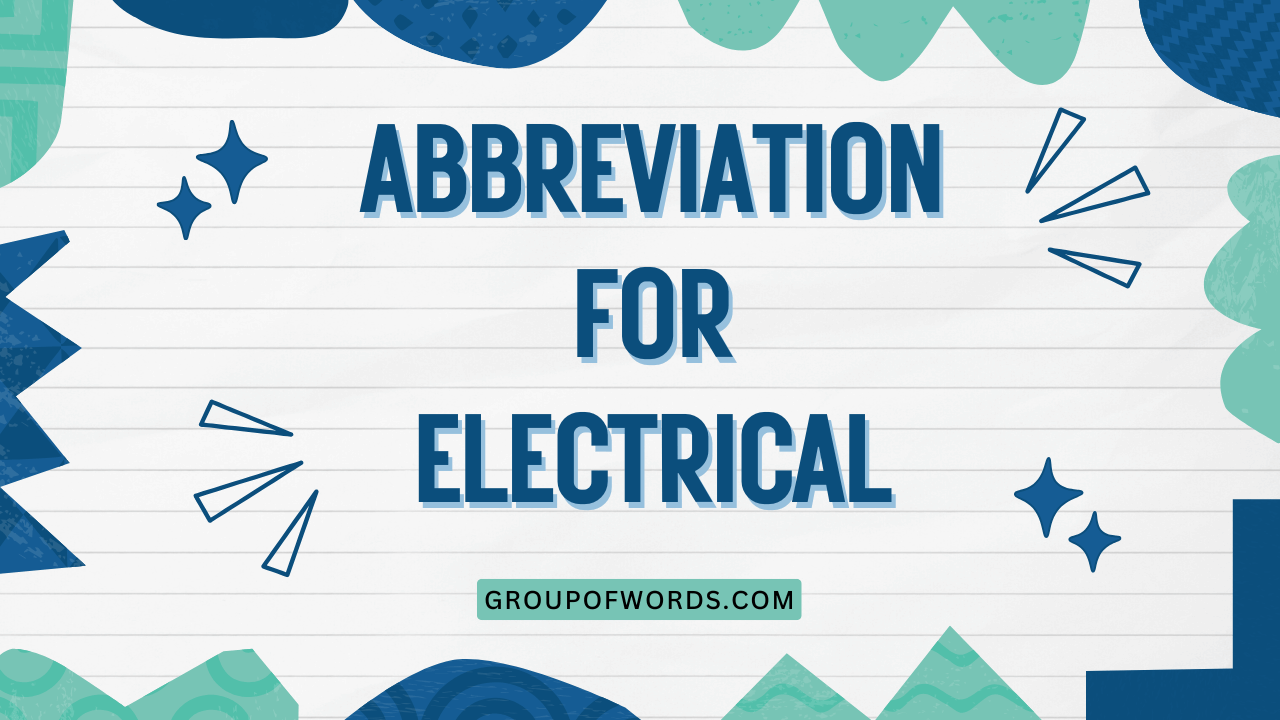Abbreviations for Electrical Terms: A Comprehensive Guide
Understanding abbreviations is crucial in various fields, and the electrical field is no exception. Electrical engineering, electronics, and related disciplines are filled with technical terms that are often shortened for convenience and clarity.
This article provides a comprehensive guide to the abbreviations used in the electrical field, explaining their meanings, applications, and proper usage. Whether you’re a student, an engineer, a technician, or simply someone interested in learning more about electricity, this guide will help you navigate the complex world of electrical abbreviations.
This article aims to clarify common abbreviations, enhance comprehension of technical documents, and improve communication within the electrical domain. Mastering these abbreviations will not only save time but also reduce the potential for misunderstandings.
By the end of this guide, you will have a solid foundation in electrical abbreviations and be able to confidently interpret and use them in various contexts.
Table of Contents
- Definition of Electrical Abbreviations
- Structural Breakdown of Electrical Abbreviations
- Types and Categories of Electrical Abbreviations
- Examples of Electrical Abbreviations
- Usage Rules for Electrical Abbreviations
- Common Mistakes with Electrical Abbreviations
- Practice Exercises
- Advanced Topics in Electrical Abbreviations
- Frequently Asked Questions (FAQ)
- Conclusion
Definition of Electrical Abbreviations
An electrical abbreviation is a shortened form of a word or phrase related to electricity, electronics, or electrical engineering. Abbreviations are used to simplify technical language, save space in documents, and expedite communication within the field.
They can represent units of measurement, circuit components, electrical systems, standards organizations, or general electrical terms. Understanding these abbreviations is essential for anyone working with or studying electrical concepts.
Electrical abbreviations can be classified based on their function. Some abbreviations represent units of measurement, such as ‘V’ for Volts or ‘A’ for Amperes.
Others denote circuit components, like ‘R’ for Resistor or ‘C’ for Capacitor. Still, others refer to electrical systems, such as ‘AC’ for Alternating Current or ‘DC’ for Direct Current.
Finally, some abbreviations represent standards organizations, like ‘IEEE’ for the Institute of Electrical and Electronics Engineers or ‘NEC’ for the National Electrical Code. Context is key to accurately interpreting the meaning of an abbreviation.
Abbreviations in the electrical field serve several critical functions. First, they enhance efficiency by reducing the length of technical documents and manuals.
Second, they improve clarity by standardizing terminology. Third, they facilitate communication among professionals by providing a common language.
Fourth, they streamline calculations and equations by representing complex terms with shorter symbols. Finally, they aid in the identification and labeling of electrical components and systems.
Structural Breakdown of Electrical Abbreviations
Electrical abbreviations typically follow certain structural patterns. Many are formed by taking the first letter or letters of the words in a phrase, such as ‘AC’ for Alternating Current or ‘DC’ for Direct Current.
Others use a combination of letters and symbols, such as ‘kW’ for Kilowatt or ‘μF’ for Microfarad. Some abbreviations are derived from Latin or Greek roots, such as ‘Hz’ for Hertz (from Heinrich Hertz) or ‘Ω’ for Ohm (the Greek letter Omega).
Understanding these structural elements can help in deciphering unfamiliar abbreviations.
The structure of an abbreviation often provides clues to its meaning. For instance, abbreviations that include ‘k’ usually refer to a multiple of 1000 (kilo-), while those that include ‘m’ often refer to a multiple of 0.001 (milli-).
Similarly, abbreviations ending in ‘C’ often refer to current or capacitance, while those ending in ‘V’ often refer to voltage. Recognizing these patterns can significantly improve comprehension and retention.
Abbreviations may also include subscripts or superscripts to provide additional information. For example, ‘Vrms‘ refers to the root mean square voltage, while ‘I2R’ represents the power loss due to current flowing through a resistance. Understanding the meaning of these subscripts and superscripts is crucial for accurate interpretation and application of electrical concepts.
Types and Categories of Electrical Abbreviations
Electrical abbreviations can be categorized based on the concepts they represent. Common categories include units of measurement, circuit components, electrical systems, and standards organizations.
Each category has its own set of abbreviations, and understanding these categories can help in organizing and remembering them.
Units of Measurement
Abbreviations for units of measurement are used to quantify electrical quantities such as voltage, current, resistance, power, and frequency. These abbreviations are essential for expressing numerical values in a concise and standardized manner.
Circuit Components
Abbreviations for circuit components are used to identify and label various elements within an electrical circuit, such as resistors, capacitors, inductors, and transistors. These abbreviations are crucial for creating schematic diagrams and understanding circuit functionality.
Electrical Systems
Abbreviations for electrical systems are used to describe different types of electrical circuits and power distribution systems, such as AC, DC, single-phase, and three-phase systems. These abbreviations are essential for understanding the characteristics and applications of different electrical systems.
Standards and Organizations
Abbreviations for standards organizations are used to refer to bodies that set standards and regulations for the electrical industry, such as IEEE, NEC, and ANSI. These abbreviations are important for ensuring compliance with industry standards and safety regulations.
Examples of Electrical Abbreviations
This section provides numerous examples of electrical abbreviations, organized by category. Each example includes the abbreviation, its full form, and a brief explanation of its meaning and usage.
Units of Measurement Examples
The following table provides examples of abbreviations for units of measurement used in the electrical field. Understanding these abbreviations is fundamental to grasping electrical concepts and calculations.
| Abbreviation | Full Form | Description |
|---|---|---|
| V | Volt | Unit of electrical potential difference or voltage. |
| A | Ampere | Unit of electrical current. |
| Ω | Ohm | Unit of electrical resistance. |
| W | Watt | Unit of electrical power. |
| Hz | Hertz | Unit of frequency (cycles per second). |
| F | Farad | Unit of capacitance. |
| H | Henry | Unit of inductance. |
| VA | Volt-Ampere | Unit of apparent power. |
| VAR | Volt-Ampere Reactive | Unit of reactive power. |
| Wh | Watt-hour | Unit of energy. |
| kWh | Kilowatt-hour | Unit of energy (1000 watt-hours). |
| mV | Millivolt | One-thousandth of a volt (0.001 V). |
| kV | Kilovolt | One thousand volts (1000 V). |
| mA | Milliampere | One-thousandth of an ampere (0.001 A). |
| kA | Kiloampere | One thousand amperes (1000 A). |
| mW | Milliwatt | One-thousandth of a watt (0.001 W). |
| kW | Kilowatt | One thousand watts (1000 W). |
| μF | Microfarad | One millionth of a farad (0.000001 F). |
| nF | Nanofarad | One billionth of a farad (0.000000001 F). |
| pF | Picofarad | One trillionth of a farad (0.000000000001 F). |
| mH | Millihenry | One-thousandth of a henry (0.001 H). |
| μH | Microhenry | One millionth of a henry (0.000001 H). |
| GHz | Gigahertz | One billion hertz (1,000,000,000 Hz). |
| MHz | Megahertz | One million hertz (1,000,000 Hz). |
Circuit Components Examples
The following table provides examples of abbreviations for circuit components commonly used in electrical schematics and diagrams.
| Abbreviation | Full Form | Description |
|---|---|---|
| R | Resistor | Component that opposes the flow of current. |
| C | Capacitor | Component that stores electrical energy in an electric field. |
| L | Inductor | Component that stores electrical energy in a magnetic field. |
| D | Diode | Semiconductor device that allows current to flow in one direction only. |
| LED | Light Emitting Diode | Semiconductor light source. |
| Q | Transistor | Semiconductor device used to amplify or switch electronic signals and electrical power. |
| SCR | Silicon Controlled Rectifier | A type of thyristor, a semiconductor device that acts as a switch. |
| Op-Amp | Operational Amplifier | A DC-coupled high-gain electronic voltage amplifier. |
| XFMR | Transformer | Device that transfers electrical energy between two or more circuits through electromagnetic induction. |
| SW | Switch | Device used to open or close an electrical circuit. |
| GND | Ground | Reference point in an electrical circuit from which voltages are measured. |
| VCC | Voltage Common Collector | Supply voltage for a bipolar junction transistor (BJT). |
| VEE | Voltage Emitter Emitter | Negative supply voltage for a bipolar junction transistor (BJT). |
| VDD | Voltage Drain Drain | Supply voltage for a MOSFET transistor. |
| VSS | Voltage Source Source | Ground or negative supply voltage for a MOSFET transistor. |
| XTAL | Crystal Oscillator | Electronic circuit that uses the mechanical resonance of a vibrating crystal of piezoelectric material to create an electrical signal with a precise frequency. |
| POT | Potentiometer | Variable resistor with three terminals. |
| REL | Relay | Electrically operated switch. |
| Fuse | Fuse | Overcurrent protection device. |
| BATT | Battery | Device that stores chemical energy and converts it into electrical energy. |
Electrical Systems Examples
The following table provides examples of abbreviations used to describe different types of electrical systems and power configurations. These abbreviations are essential for understanding the operation and characteristics of various electrical installations.
| Abbreviation | Full Form | Description |
|---|---|---|
| AC | Alternating Current | Electrical current that periodically reverses direction. |
| DC | Direct Current | Electrical current that flows in one direction only. |
| 1-Φ | Single-Phase | Electrical power system with a single alternating current. |
| 3-Φ | Three-Phase | Electrical power system with three alternating currents. |
| GFC | Ground Fault Circuit | Circuit that protects against electrical shock by detecting ground faults. |
| UPS | Uninterruptible Power Supply | Backup power system that provides continuous power in the event of a power outage. |
| HVAC | Heating, Ventilation, and Air Conditioning | System used to control temperature, humidity, and air quality in buildings. |
| PV | Photovoltaic | Conversion of light into electricity using semiconductor materials. |
| EMS | Energy Management System | System used to monitor, control, and optimize energy consumption. |
| SCADA | Supervisory Control and Data Acquisition | Control system architecture comprising computers, networked data communications and graphical user interfaces for high-level process supervisory management. |
| PLC | Programmable Logic Controller | A digital computer used for automation of electromechanical processes, such as control of machinery on factory assembly lines, amusement rides, or light fixtures. |
| ATS | Automatic Transfer Switch | A switch that automatically transfers a power supply from its primary source to a backup source when the primary source fails. |
| MCC | Motor Control Center | An assembly of one or more enclosed sections having a common power bus and principally containing motor control units. |
| VFD | Variable Frequency Drive | A type of motor controller that drives an electric motor by varying the frequency and voltage of its power supply. |
| CHP | Combined Heat and Power | An efficient technology that generates electricity and captures the heat that is produced in the process. |
| ESS | Energy Storage System | A system that stores electrical energy for later use. |
| EV | Electric Vehicle | A vehicle that uses an electric motor for propulsion. |
| HEV | Hybrid Electric Vehicle | A vehicle that combines an internal combustion engine with an electric motor. |
| PHEV | Plug-in Hybrid Electric Vehicle | A hybrid electric vehicle that can be recharged by plugging it into an external power source. |
Standards and Organizations Examples
The following table provides examples of abbreviations for standards organizations and codes that regulate the electrical industry. Familiarity with these abbreviations is important for ensuring compliance with safety and performance standards.
| Abbreviation | Full Form | Description |
|---|---|---|
| IEEE | Institute of Electrical and Electronics Engineers | Professional organization for electrical engineers and related fields. |
| NEC | National Electrical Code | Standard for the safe installation of electrical wiring and equipment in the United States. |
| ANSI | American National Standards Institute | Organization that develops and publishes standards for various industries. |
| IEC | International Electrotechnical Commission | International standards organization that prepares and publishes international standards for all electrical, electronic and related technologies. |
| UL | Underwriters Laboratories | Safety certification company that tests and certifies products for safety. |
| CSA | Canadian Standards Association | Organization that develops standards and provides testing and certification services for products in Canada. |
| NEMA | National Electrical Manufacturers Association | Trade association of electrical equipment manufacturers. |
| NFPA | National Fire Protection Association | Organization that develops codes and standards for fire prevention and safety. |
General Electrical Terms Examples
The following table provides examples of abbreviations for general electrical terms and concepts. These abbreviations are commonly used in electrical engineering and related fields.
| Abbreviation | Full Form | Description |
|---|---|---|
| EMF | Electromotive Force | Voltage generated by a battery or generator. |
| PCB | Printed Circuit Board | A board that connects electronic components using conductive tracks, pads and other features etched from one or more sheet layers of copper laminated onto and/or between sheet layers of a non-conductive substrate. |
| THD | Total Harmonic Distortion | Measure of the distortion of a voltage or current waveform. |
| PF | Power Factor | Ratio of real power to apparent power in an AC circuit. |
| RMS | Root Mean Square | Statistical measure of the magnitude of a varying quantity. |
| AWG | American Wire Gauge | Standardized wire gauge system used in North America. |
| GFCI | Ground Fault Circuit Interrupter | Device that protects against electrical shock by detecting ground faults. |
| ESD | Electrostatic Discharge | Sudden flow of electricity between two electrically charged objects caused by contact, an electrical short, or dielectric breakdown. |
| EMI | Electromagnetic Interference | Disturbance caused by electromagnetic radiation that can affect electrical circuits. |
| MOV | Metal Oxide Varistor | Voltage-dependent resistor used to protect electrical circuits from voltage surges. |
| EOL | End of Life | The point at which a device or system is no longer supported or manufactured. |
Usage Rules for Electrical Abbreviations
Using electrical abbreviations correctly is crucial for clear and accurate communication. Here are some general rules to follow:
- Consistency: Use the same abbreviation consistently throughout a document or project.
- Clarity: If there’s any doubt about whether an abbreviation will be understood, spell out the full term on first use and then include the abbreviation in parentheses. For example: “Alternating Current (AC) is used in most household circuits.”
- Context: Always consider the context in which the abbreviation is being used. Some abbreviations have multiple meanings depending on the field or application.
- Units: When using abbreviations for units of measurement, ensure that the numerical value is clearly indicated. For example: “120 V” (not just “120”).
- Formal vs. Informal: In formal technical documents, it’s generally best to spell out terms on first use. In informal settings, such as internal emails or discussions with colleagues, abbreviations can be used more freely.
- Standards: Adhere to industry standards and conventions when using abbreviations. Consult relevant standards documents (such as IEEE or IEC standards) for guidance.
Common Mistakes with Electrical Abbreviations
Even experienced professionals can make mistakes when using electrical abbreviations. Here are some common errors to avoid:
- Misinterpreting abbreviations: Failing to understand the correct meaning of an abbreviation can lead to errors in calculations and communication.
- Using abbreviations inconsistently: Switching between different abbreviations for the same term can cause confusion.
- Omitting units: Forgetting to include the unit of measurement when using an abbreviation can make the value meaningless.
- Using non-standard abbreviations: Creating or using abbreviations that are not widely recognized can hinder communication.
- Ignoring context: Failing to consider the context in which an abbreviation is used can lead to misinterpretations.
Here are some examples of correct vs. incorrect usage:
| Incorrect | Correct | Explanation |
|---|---|---|
| The voltage is 120. | The voltage is 120 V. | The unit “V” (Volts) must be included. |
| The circuit has R. | The circuit has a resistor (R). | Spell out the term on first use for clarity. |
| The freq is 60 Hz. | The frequency is 60 Hz. | Use the correct abbreviation “Hz” for Hertz. |
| We need a big cap. | We need a large capacitor (C). | “Cap” is too informal; use “capacitor” or its abbreviation “C”. |
Practice Exercises
Test your knowledge of electrical abbreviations with the following practice exercises. For each question, provide the full form of the abbreviation.
Exercise 1: Units of Measurement
| Question | Answer |
|---|---|
| What does “V” stand for? | Volt |
| What does “A” stand for? | Ampere |
| What does “Ω” stand for? | Ohm |
| What does “W” stand for? | Watt |
| What does “Hz” stand for? | Hertz |
| What does “F” stand for? | Farad |
| What does “H” stand for? | Henry |
| What does “VA” stand for? | Volt-Ampere |
| What does “VAR” stand for? | Volt-Ampere Reactive |
| What does “Wh” stand for? | Watt-hour |
Exercise 2: Circuit Components
| Question | Answer |
|---|---|
| What does “R” stand for? | Resistor |
| What does “C” stand for? | Capacitor |
| What does “L” stand for? | Inductor |
| What does “D” stand for? | Diode |
| What does “LED” stand for? | Light Emitting Diode |
| What does “Q” stand for? | Transistor |
| What does “XFMR” stand for? | Transformer |
| What does “SW” stand for? | Switch |
| What does “GND” stand for? | Ground |
| What does “BATT” stand for? | Battery |
Exercise 3: Electrical Systems
| Question | Answer |
|---|---|
| What does “AC” stand for? | Alternating Current |
| What does “DC” stand for? | Direct Current |
| What does “UPS” stand for? | Uninterruptible Power Supply |
| What does “HVAC” stand for? | Heating, Ventilation, and Air Conditioning |
| What does “PV” stand for? | Photovoltaic |
| What does “EMS” stand for? | Energy Management System |
| What does “SCADA” stand for? | Supervisory Control and Data Acquisition |
| What does “PLC” stand for? | Programmable Logic Controller |
| What does “ATS” stand for? | Automatic Transfer Switch |
| What does “VFD” stand for? | Variable Frequency Drive |
Exercise 4: Standards and Organizations
| Question | Answer |
|---|---|
| What does “IEEE” stand for? | Institute of Electrical and Electronics Engineers |
| What does “NEC” stand for? | National Electrical Code |
| What does “ANSI” stand for? | American National Standards Institute |
| What does “IEC” stand for? | International Electrotechnical Commission |
| What does “UL” stand for? | Underwriters Laboratories |
| What does “CSA” stand for? | Canadian Standards Association |
| What does “NEMA” stand for? | National Electrical Manufacturers Association |
| What does “NFPA” stand for? | National Fire Protection Association |
Advanced Topics in Electrical Abbreviations
For advanced learners, it’s important to understand the nuances of electrical abbreviations and their applications in specific contexts. This includes delving into the history of certain abbreviations, understanding the evolution of standards, and recognizing the regional variations in abbreviation usage.
Furthermore, advanced learners should be familiar with the use of abbreviations in specialized areas such as power electronics, control systems, and telecommunications. Each of these fields has its own set of abbreviations that are commonly used in technical literature and industry practice.
For example, in power electronics, abbreviations like IGBT (Insulated Gate Bipolar Transistor) and MOSFET (Metal-Oxide-Semiconductor Field-Effect Transistor) are frequently encountered.
Another advanced topic is the use of abbreviations in complex equations and formulas. In many cases, abbreviations are used to represent variables and parameters in mathematical models of electrical systems.
Understanding these abbreviations is essential for interpreting and applying these models correctly.
Frequently Asked Questions (FAQ)
Here are some frequently asked questions about electrical abbreviations:
- Why are abbreviations used in the electrical field?
Abbreviations are used to simplify technical language, save space in documents, and expedite communication among professionals. They provide a concise way to refer to complex concepts and quantities.
- Where can I find a comprehensive list of electrical abbreviations?
Comprehensive lists of electrical abbreviations can be found in electrical engineering handbooks, standards documents (such as IEEE standards), and online resources. Many websites and databases compile lists of abbreviations used in various technical fields.
- Are there any regional differences in the use of electrical abbreviations?
Yes, there can be regional differences in the use of electrical abbreviations. Some abbreviations may be more common in certain countries or regions than others. It’s important to be aware of these differences and to use abbreviations that are appropriate for the audience and context.
- How can I ensure that I am using electrical abbreviations correctly?
To ensure that you are using electrical abbreviations correctly, always refer to authoritative sources, such as standards documents and technical handbooks. Also, be consistent in your usage and provide the full form of the abbreviation on first use if there is any doubt about whether it will be understood.
- What should I do if I encounter an unfamiliar electrical abbreviation?
If you encounter an unfamiliar electrical abbreviation, try to find its definition in a glossary of electrical terms or by searching online. If you are still unsure of its meaning, ask a colleague or expert in the field.
- Are all electrical abbreviations standardized?
While many electrical abbreviations are standardized by organizations like IEEE and IEC, not all abbreviations are universally recognized. Some abbreviations may be specific to a particular company or industry. It’s important to be aware of this and to use abbreviations that are widely accepted and understood.
- Is it acceptable to create my own electrical abbreviations?
It is generally not recommended to create your own electrical abbreviations unless there is a very compelling reason to do so. Using non-standard abbreviations can cause confusion and hinder communication. If you must create a new abbreviation, be sure to define it clearly and use it consistently.
- How do I handle plural forms of abbreviations (e.g., multiple resistors)?
For most electrical abbreviations, the plural form is the same as the singular form. For example, “R” can refer to a single resistor or multiple resistors. In some cases, you may choose to use the plural form of the full term (e.g., “resistors”) for clarity.
Conclusion
Mastering electrical abbreviations is essential for anyone involved in the electrical field. This comprehensive guide has provided a detailed overview of the definition, structure, types, usage rules, and common mistakes associated with electrical abbreviations.
By understanding these concepts and practicing the exercises provided, you can significantly improve your ability to interpret technical documents, communicate effectively with colleagues, and work safely and efficiently in the electrical domain.
Remember that consistency, clarity, and context are key to using electrical abbreviations correctly. When in doubt, always refer to authoritative sources and spell out the full term on first use.
With continued practice and attention to detail, you can become proficient in the use of electrical abbreviations and enhance your understanding of electrical concepts.






